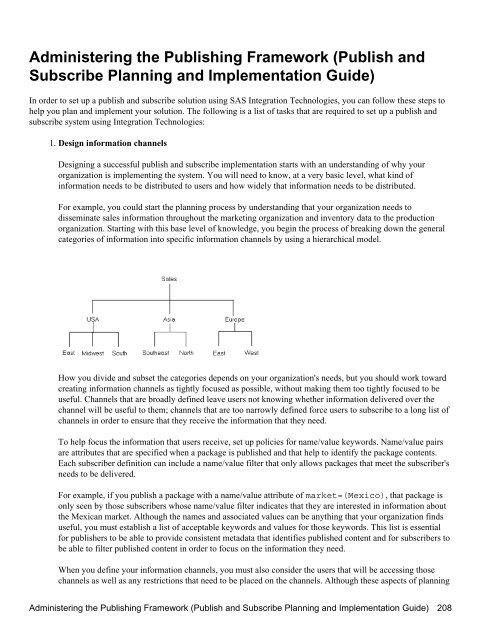SAS® Integration Technologies: Administrator's Guide (LDAP Version)
SAS® Integration Technologies: Administrator's Guide (LDAP Version)
SAS® Integration Technologies: Administrator's Guide (LDAP Version)
You also want an ePaper? Increase the reach of your titles
YUMPU automatically turns print PDFs into web optimized ePapers that Google loves.
Administering the Publishing Framework (Publish and<br />
Subscribe Planning and Implementation <strong>Guide</strong>)<br />
In order to set up a publish and subscribe solution using SAS <strong>Integration</strong> <strong>Technologies</strong>, you can follow these steps to<br />
help you plan and implement your solution. The following is a list of tasks that are required to set up a publish and<br />
subscribe system using <strong>Integration</strong> <strong>Technologies</strong>:<br />
1. Design information channels<br />
Designing a successful publish and subscribe implementation starts with an understanding of why your<br />
organization is implementing the system. You will need to know, at a very basic level, what kind of<br />
information needs to be distributed to users and how widely that information needs to be distributed.<br />
For example, you could start the planning process by understanding that your organization needs to<br />
disseminate sales information throughout the marketing organization and inventory data to the production<br />
organization. Starting with this base level of knowledge, you begin the process of breaking down the general<br />
categories of information into specific information channels by using a hierarchical model.<br />
How you divide and subset the categories depends on your organization's needs, but you should work toward<br />
creating information channels as tightly focused as possible, without making them too tightly focused to be<br />
useful. Channels that are broadly defined leave users not knowing whether information delivered over the<br />
channel will be useful to them; channels that are too narrowly defined force users to subscribe to a long list of<br />
channels in order to ensure that they receive the information that they need.<br />
To help focus the information that users receive, set up policies for name/value keywords. Name/value pairs<br />
are attributes that are specified when a package is published and that help to identify the package contents.<br />
Each subscriber definition can include a name/value filter that only allows packages that meet the subscriber's<br />
needs to be delivered.<br />
For example, if you publish a package with a name/value attribute of market=(Mexico), that package is<br />
only seen by those subscribers whose name/value filter indicates that they are interested in information about<br />
the Mexican market. Although the names and associated values can be anything that your organization finds<br />
useful, you must establish a list of acceptable keywords and values for those keywords. This list is essential<br />
for publishers to be able to provide consistent metadata that identifies published content and for subscribers to<br />
be able to filter published content in order to focus on the information they need.<br />
When you define your information channels, you must also consider the users that will be accessing those<br />
channels as well as any restrictions that need to be placed on the channels. Although these aspects of planning<br />
Administering the Publishing Framework (Publish and Subscribe Planning and Implementation <strong>Guide</strong>) 208
















